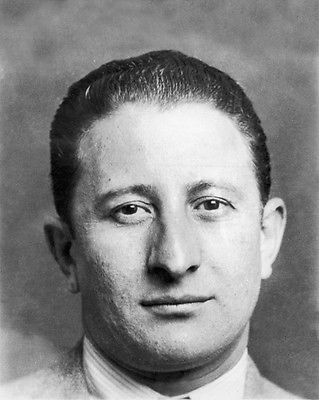“Don” Carlo Gambino was born on August 24, 1902, in Caccamo, a province of Palermo Sicily. He had two brothers, Gaspare who was never involved in the Mafia, and Paolo who would eventually work alongside his brother in the American Mafia.
In Italy, Gambino’s family belonged to the Honored Society, an Italian version of the Black Hand in the United States. The Black Hand was a less organized version of Italian gangsters, most of which immigrated to the United States.
In 1921 Gambino illegally boarded a ship headed for the United States. It’s been said he ate nothing but anchovies and wine during the month-long trip. Once in the United States, he joined his cousins, the Castellano’s in New York City.
The Castellano’s were already affiliated with the D’Aquila gang and quickly introduced Gambino as a new member. By the end of 1921 at the age of 19, Carlo Gambino became a “made man” of the American Mafia.

Around the same time, Gambino also became close with an Italian and Jewish gang called the “Young Turks” in New York. The gang included notables such as Frank Costello, Albert Anastasia, Frank Scalise, Settimo Accardi, Tommy Lucchese, Joe Adonis, Vito Genovese, Meyer Lansky, Bugsy Siegel, and Mickey Cohen. The Turks were led by Charles “Lucky” Luciano, the future creator of the Mafia Commission.
After several years of fighting for territory among the different gangs in and around New York, two men emerged holding the most power. Giuseppe “Joe the Boss” Masseria and Salvatore Maranzano a Palermo bore mafioso who recently arrived in the United States. Maranzano quickly inserted himself in extortion and gambling operations that directly competed with Masseria. On October 10, 1928, Masseria had rival Toto D’Aquila, once the most powerful mobster in New York, murdered clearing the way for him to become the “Boss of Bosses.” However, Maranzano and the Castellammarese Clan he brought with him from Palermo, stood in his way.
In 1930, Masseria flexed his muscle and went after Marranzano’s then boss, Nicola “Cola” Schiro demanding a $10,000 tribute. Schiro, fearing for his life against the more powerful Masseria paid the tribute and fled New York leaving Maranzano as the gang’s new leader. It was this move that set the wheels in motion for the start of one of the most massive gangland wars in history; the Castellammarese War.
By 1931, Masseria had begun to eliminate Maranzano’s Castellammarese Clan. His goal was to weaken Maranzano and take over New York. However, Maranzano would not go down without a fight and declared war on Masseria and anyone else who aligned themselves with him.
Gambino and Alfred Mineo the new leader of the D’Aquila gang aligned with Masseria. Half of the Young Turks joined as well, with the others aligning with Maranzano. The Castellammarese Clan included Joe Bonanno, Stefano Magaddino, and the Profaci crime family, which included Joseph Profaci and Joseph Magliocco. Former Masseria allies Gaetano Reina, boss of the Reina family and Tommy Lucchese also joined the Castellammarese and Maranzano.
The war went on between these two factions for nearly 4 years. It was the height of prohibition where profits were large; however, the war almost completely destroyed many of the New York family rackets. Luciano and members of the Young Turks from both sides began to realize the war needed to stop and stop soon or much of what they took so long to build in New York City would be lost. During the war, many of the Jewish and Irish crime families became the dominant families in New York. Meyer Lansky, a Jewish mobster and close confidant of Luciano felt that Masseria and Maranzano were old-school mafioso who were too greedy to see the riches that could be had by working with non-Italians. Gambino and the Young Turks agreed and decided to end the war and form a national syndicate led by Charles Luciano.

On April 15, 1931, Masseria was murdered by Luciano associates Albert Anastasia, Joe Adonis, Vito Genovese, and Bugsy Siegel while dining at Nuova Villa Tammaro restaurant in Coney Island. With Masseria out of the way, Marranzano declared himself the Boss of Bosses and with the help of Luciano’s vision, re-organized the New York gangs into five Mafia families. Vincent Mangano was promoted and took over Masseria’s Mineo family. Young Turk, Albert Anastasia became his underboss, and Gambino was promoted to Capo.
On September 10, 1931, Maranzano was murdered by Luciano gunmen ending his reign as Boss of Bosses. With Maranzano gone Luciano called a meeting of all the bosses in New York and the United States. During this meeting many of the bosses including Al Capone of the Chicago Outfit expected Luciano to declare himself Boss of Bosses. However, Luciano had another idea and during the meeting laid out his plan to create The Commission, a ruling panel of crime family leaders which would mediate conflicts between the families. The leaders nominated Luciano, Joe Bonanno, Joe Profaci, Tommy Gagliano, and Vincent Mangano as its inaugural members.
With a seat on the Commission, the Mangano family set out to become one of the most powerful mafia families in the country. Gambino quickly became one of the family’s top earners and controlled several illegal rackets including loansharking, illegal gambling, and protection.
